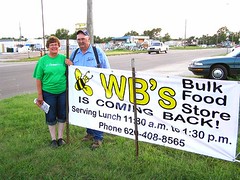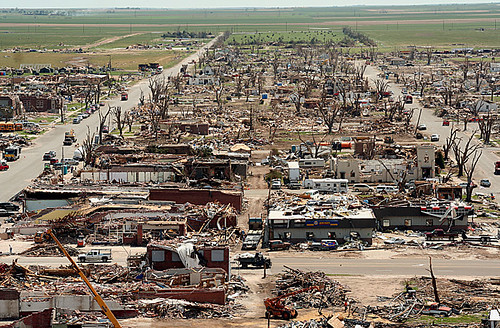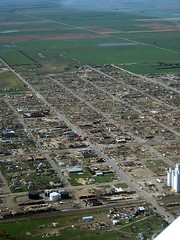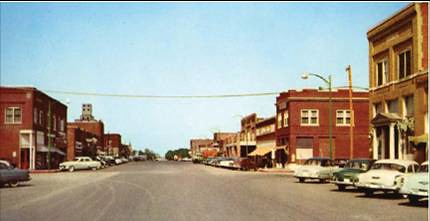True to its name, Greensburg rebuilds sustainably after tragedy

Posted June 5, 2008 at 3:55AM
While the US Congress debates the most important global warming legislation and arguably the most important federal environmental legislation of this young century, it can be instructive and heartening to look at some local community actions that are addressing the issue on the ground.
As too often seems to be the case lately, these stories can show that ordinary citizens are ahead of the legislators. And no example is more inspiring, or more quintessentially American, than that of Greensburg, Kansas. After complete devastation, Greensburg is now positioning itself to become the most sustainable community in America.
Greensburg, a rural town of about 1500 people as of the last census, was literally wiped off the landscape by a tornado last year. The tragedy killed eleven people and destroyed essentially all of the town’s homes, shops, and other built environment:
As noted in the town’s Wikipedia entry, “the tornado was estimated to be 1.7 miles in width and traveled for nearly 22 miles. Ninety-five percent of the city was confirmed to be destroyed, with the other five percent being severely damaged. The National Weather Service estimated winds of the tornado to reach 205 mph.” It was the worst tornado rated by the NWS since at least May 1999.
Here’s what Greensburg once looked like, from a mid-century postcard:
For the people involved, this was on a par with the devastation wreaked by the more famous Hurricane Katrina. Writer Bryan Walsh captured the story for Time:
"I could only think of Hiroshima," remembers Lonnie McCollum, then the town's mayor. "Big strong men looked at what was left and were damn near in tears." Over 1,000 people — more than two-thirds of the town's population — were left homeless. Despite the help that poured in over the following weeks from FEMA, from charities and from nearby towns, residents feared their town had suffered a deathblow. Like many rural Midwestern towns, Greensburg had been losing population for years. Jobs had grown scarce, and few in the town's shrinking high school classes stayed on after graduation. Why rebuild a dying town? "We were barely making it before the tornado," says Wylan Fleener, whose century-old furniture store was reduced to a pile of bricks by the storm. "I thought about leaving every day."
But, just as the victims of Katrina have had to, Greensburg has done its best to come back together. And its best is turning out to be very good indeed.
 Temporary buildings were quickly established with federal and state disaster assistance. As ABC News noted three months after the damage, “every member of the high school football team has returned.” School resumed in temporary trailers and principal Randy Fulton told ABC that "we're not going to let this tornado disrupt our lives. … We want kids to understand that just because all of this is going on, they still need to have some normalcy in their lives." (Temporary trailers still house many town functions.)
Temporary buildings were quickly established with federal and state disaster assistance. As ABC News noted three months after the damage, “every member of the high school football team has returned.” School resumed in temporary trailers and principal Randy Fulton told ABC that "we're not going to let this tornado disrupt our lives. … We want kids to understand that just because all of this is going on, they still need to have some normalcy in their lives." (Temporary trailers still house many town functions.)
Greensburg was forced to rebuild practically from scratch. This created an unprecedented, if also unwanted, opportunity for the townspeople to re-conceive what they wanted in their community. Almost immediately, Kansas Governor Kathleen Sebelius recommended that Greensburg consider rebuilding “green,” and the town’s mayor began to work with the town to do just that. The state energy office pitched in to help with sustainable rebuilding. The federal Department of Agriculture provided funding for planning, along with the Federal Emergency Management Agency.
 A key development was the involvement, on the state’s recommendation, of Berkebile Nelson Immenschuh McDowell Architects (BNIM), a Kansas City firm experienced and highly skilled in sustainable design and recovery. BNIM became an early contributor to the town’s initial recovery efforts, working with community members and town officials as well as local, state and federal organizations like FEMA.
A key development was the involvement, on the state’s recommendation, of Berkebile Nelson Immenschuh McDowell Architects (BNIM), a Kansas City firm experienced and highly skilled in sustainable design and recovery. BNIM became an early contributor to the town’s initial recovery efforts, working with community members and town officials as well as local, state and federal organizations like FEMA.
By July, two months after the tornado struck, BNIM was facilitating community involvement in a design workshop and working with the town on the official community recovery plan. By October, BNIM was hired by the town to help them write a long-range comprehensive master plan.
The 157-page plan, fleshed out over months of hard work and officially adopted last month, is now known as the Greensburg Sustainable Comprehensive Plan. If there’s a better town or city plan for incorporating the values of sustainability, I haven’t seen it. From green buildings to walkable streets to transportation choices to sustainable hazard mitigation, the plan is a true blueprint for a new kind of green community, yet rooted in traditional heartland values. In my next post I’ll tell you why.


